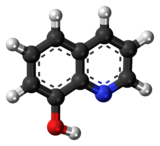8-Hydroxyquinoline
This article addresses the topic of 8-Hydroxyquinoline from different perspectives, with the aim of providing a complete and enriching vision of this broad and varied topic. Different points of view, recent research, expert opinions and practical examples will be presented that will allow the reader to delve into 8-Hydroxyquinoline in a deep and enriching way. Likewise, the implications and consequences that 8-Hydroxyquinoline can have in different areas of life will be analyzed, as well as the possible solutions or recommendations that can be carried out in relation to this issue. Read on to find out everything you need to know about 8-Hydroxyquinoline!

| |

| |

| |
| Names | |
|---|---|
| Preferred IUPAC name
Quinolin-8-ol | |
| Other names
1-Azanaphthalene-8-ol, Fennosan H 30, Hydroxybenzopyridine, Oxybenzopyridine, Oxychinolin, Oxyquinoline, Phenopyridine, Quinophenol, Oxine, 8-Quinolinol
| |
| Identifiers | |
3D model (JSmol)
|
|
| ChEBI | |
| ChEMBL | |
| ChemSpider | |
| ECHA InfoCard | 100.005.193 |
| KEGG | |
PubChem CID
|
|
| UNII | |
CompTox Dashboard (EPA)
|
|
| |
| |
| Properties | |
| C9H7NO | |
| Molar mass | 145.16 g/mol |
| Appearance | White crystalline powder |
| Density | 1.034 g/cm3 |
| Melting point | 76 °C (169 °F; 349 K) |
| Boiling point | 276 °C (529 °F; 549 K) |
| Pharmacology | |
| G01AC30 (WHO) A01AB07 (WHO) D08AH03 (WHO) R02AA14 (WHO) | |
| Hazards | |
| GHS labelling: | |
   
| |
| Danger | |
| H301, H317, H318, H360D, H410 | |
| P202, P273, P280, P301+P310, P302+P352, P305+P351+P338 | |
| Safety data sheet (SDS) | External MSDS |
Except where otherwise noted, data are given for materials in their standard state (at 25 °C , 100 kPa).
| |
8-Hydroxyquinoline (also known as oxine) is an organic compound derived from the heterocycle quinoline. A colorless solid, its conjugate base is a chelating agent, which is used for the quantitative determination of metal ions.
In aqueous solution 8-hydroxyquinoline has a pKa value of ca. 9.9 It reacts with metal ions, losing the proton and forming 8-hydroxyquinolinato-chelate complexes.

The aluminium complex, is a common component of organic light-emitting diodes (OLEDs). Substituents on the quinoline ring affect the luminescence properties.
In its photo-induced excited-state, 8-hydroxyquinoline converts to zwitterionic isomers, in which the hydrogen atom is transferred from oxygen to nitrogen.
Bioactivity
The complexes as well as the heterocycle itself exhibit antiseptic, disinfectant, and pesticide properties, functioning as a transcription inhibitor. Its solution in alcohol is used in liquid bandages. It once was of interest as an anti-cancer drug.
A thiol analogue, 8-mercaptoquinoline is also known.
The roots of the invasive plant Centaurea diffusa release 8-hydroxyquinoline, which has a negative effect on plants that have not co-evolved with it.
See also
- Nitroxoline (5-nitro-8-hydroxyquinoline), an antiprotozoal drug
- PBT2
- QUPIC
- Ionophore
- Trace metal detection test
References
- ^ Albert, A.; Phillips, J. N. (1956). "264. Ionization Constants of Heterocyclic Substances. Part II. Hydroxy-Derivatives of Nitrogenous Six-Membered Ring-Compounds". Journal of the Chemical Society (Resumed). 1956: 1294–1304. doi:10.1039/JR9560001294.
- ^ Cölle, M.; Dinnebier, R. E.; Brütting, W. (2002). "The structure of the blue luminescent δ-phase of tris(8-hydroxyquinoline)aluminium(III) (Alq3)". Chemical Communications. 2002 (23): 2908–9. doi:10.1039/b209164j. PMID 12478807. S2CID 96135270.
- ^ Katakura, R.; Koide, Y. (2006). "Configuration-Specific Synthesis of the Facial and Meridional Isomers of Tris(8-hydroxyquinolinate)aluminum (Alq3)". Inorganic Chemistry. 45 (15): 5730–5732. doi:10.1021/ic060594s. PMID 16841973.
- ^ Montes, V. A.; Pohl, R.; Shinar, J.; Anzenbacher, P. Jr. (2006). "Effective Manipulation of the Electronic Effects and Its Influence on the Emission of 5-Substituted Tris(8-quinolinolate) Aluminum(III) Complexes". Chemistry: A European Journal. 12 (17): 4523–4535. doi:10.1002/chem.200501403. PMID 16619313.
- ^ Bardez, E.; Devol, I.; Larrey, B.; Valeur, B. (1997). "Excited-State Processes in 8-Hydroxyquinoline: Photoinduced Tautomerization and Solvation Effects". The Journal of Physical Chemistry B. 101 (39): 7786–7793. doi:10.1021/jp971293u.
- ^ Phillips, J. P. (1956). "The Reactions of 8-Quinolinol". Chemical Reviews. 56 (2): 271–297. doi:10.1021/cr50008a003.
- ^ "8-Hydroxyquinoline". Medical Dictionary Online. Archived from the original on 2016-10-09. Retrieved 2016-03-09.
- ^ "8-Hydroxyquinoline". Sigma-Aldrich. Retrieved 2022-02-15.
- ^ Shen, A. Y.; Wu, S. N.; Chiu, C. T. (1999). "Synthesis and Cytotoxicity Evaluation of some 8-Hydroxyquinoline Derivatives". Journal of Pharmacy and Pharmacology. 51 (5): 543–548. doi:10.1211/0022357991772826. PMID 10411213. S2CID 33085238.
- ^ Fleischer, H. (2005). "Structural Chemistry of Complexes of (n-1)d10ns Metal Ions with β-N-Donor Substituted Thiolate Ligands (m=0, 2)". Coordination Chemistry Reviews. 249 (7–8): 799–827. doi:10.1016/j.ccr.2004.08.024.
- ^ Vivanco, J.M.; Bais, H.P.; Stermitz, F.R.; Thelen, G.C.; Callaway, R.M. (2004). "Biogeographical variation in community response to root allelochemistry: novel weapons and exotic invasion". Ecology Letters. 7 (4): 285–292. Bibcode:2004EcolL...7..285V. doi:10.1111/j.1461-0248.2004.00576.x.